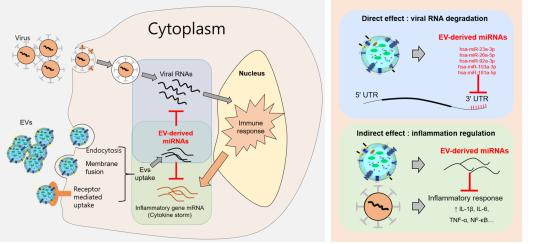A research team of CHA University has presented the world's first study, which shows that micro ribonucleic acids (miRNA) extracted from extracellular vesicles derived from placental stem cells have preventive and therapeutic effects against Covid-19.
By comparing the analysis of genome sequencing of 95 coronaviruses throughout the world, the research team, led by Professor Moon Ji-sook, found that a similar genetic sequence at the end of the messenger RNA called the three prime untranslated regions (3' UTR) in the mutated coronavirus RNA genome.

The study revealed that even if the coronavirus mutates, a treatment that inhibits the 3' UTR can treat any variant of coronavirus as the site hardly changes.
The research team analyzed molecular data by separating extracellular vesicles from placenta stem cells and by-products. As a result, five out of 84 microRNAs present in the extracellular vesicles combined with the 3' UTR of the coronavirus and inhibited viral expression.
Researchers also confirmed that miRNA inhibited the reproduction of the virus and had an excellent anti-inflammatory effect at the same time to prevent cytokine storm caused by an excessive immune response, which is one of the typical symptoms in severe Covid-19 patients.
"By using the treatment effects of extracellular vesicles derived from placenta stem cells, we will be able to develop preventive and therapeutic agents that can proactively respond to not only coronavirus but also similar RNA viruses," Professor Moon said.
The study, titled, "Antiviral effects of miRNAs in extracellular vesicles against severe acute respiratory syndrome coronavirus 2 (SARS-CoV-2) and mutations in SARS-CoV-2 RNA virus," was published on the preprint website “bioRxiv.”
The research team has been developing technology to extract extracellular vesicles from placenta stem cells and conducted this study after judging that the blisters can be formed as treatments for various diseases by taking advantage of their ability to freely move to inflammatory environments and infected areas along with excellent immune control functions.
The research was carried out as part of a project for developing source technology of stem cell fusion with the support of the Ministry of Science and ICT and the National Research Foundation of Korea.

